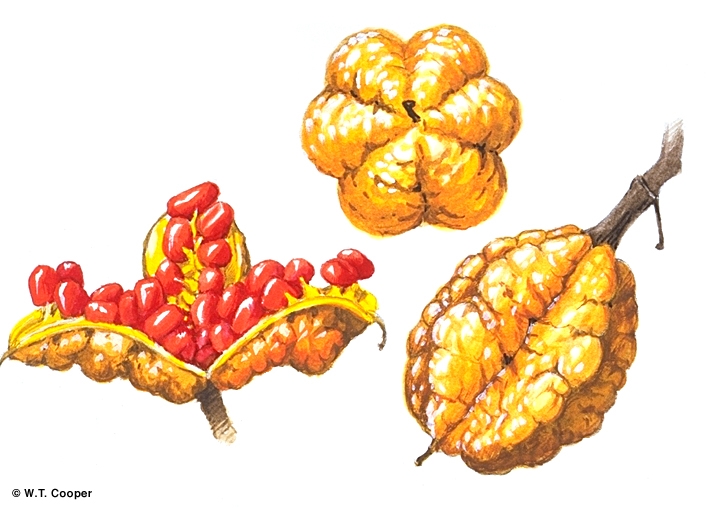Australian Tropical Rainforest Plants - Online edition
Pittosporum revolutum Dryand. ex W.T.Aiton






Dryander, J. in Aiton, W.T. (1811) Hortus Kewensis 2: 27. Type: Nat. of New South Wales. ex Hort. Kew; holo: K. Fide Cooper (1956).
Hairy Pittosporum; Yellow Pittosporum; Rough-fruit Pittosporum; Revolute Pittosporum; Pittosporum, Revolute; Pittosporum, Lemon-fruit; Pittosporum, Hairy; Laurel, Brisbane; Brisbane Laurel; Lemon-fruit Pittosporum
Occasionally grows into a small tree but usually flowers and fruits as a shrub about 1-3 m tall.
Scale leaves normally present on the twigs between the whorls of leaves. Leaf blades about 6-17 x 2.5-6 cm, densely clothed in matted, tortuous, brown hairs, young shoots, terminal buds, twigs and petioles similarly clothed. Lateral veins curving well inside the blade margin forming indistinct loops. Petiole grooved or flattened on the upper surface. Small white or pale coloured lenticels usually visible on the twigs.
Sepals linear, about 4-8 x 1.5 mm, sparsely rusty tomentose eventually becoming +/- glabrous. Petals glabrous, about 12.5-18 x 2.5-5 mm, coherent for about two thirds of their length in a cylindrical or somewhat urceolate tube. Stamens about 6.5-12 mm long, filaments glabrous, base of the filaments broader than the anthers. Ovary densely pubescent, clothed in long brown hairs, style and stigma glabrous.
Capsules ellipsoid to subglobose, about 15-28 x 11-21 mm, coarsely rugose on the outer surface, valves woody, about 2-3 mm thick, yellow on the inner surface. Placentas with funicles attached nearly all the way from the base to near the apex. Seeds about 20-76, reddish brown, immersed in a white sticky substance. Embryo small, difficult to find, about 0.5 mm long, cotyledons no wider than the radicle.
Cotyledons about 19-21 x 11 mm, apex apiculate, At the tenth leaf stage: leaf blade obovate, apex abruptly acuminate, base cuneate or attenuate, margin somewhat recurved. Cataphylls present between successive leaf flushes. Stem, leaf blade, petiole and bud densely clothed in tortuous and straight rusty coloured hairs. Seed germination time 63 to 77 days.
Endemic to Australia, occurs in NEQ, CEQ and southwards to Victoria. Altitudinal range from near sea level to 1100 m. Usually grows in open forest but can grow in and on the margins of some of the drier types of rain forest.
This attractive shrub is now starting to gain popularity and is an outstanding plant even for a small garden. It has bunches of yellow flowers that are followed by large orange fruit which split to reveal red seeds.





